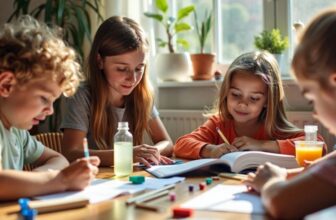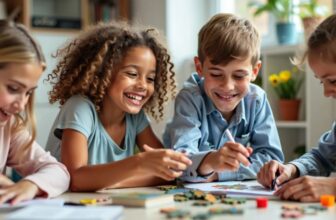
Innovative educational activities play a crucial role in engaging students in learning by making the process interactive and enjoyable. By incorporating various hands-on and immersive experiences, educators can create a dynamic learning environment that enhances student participation and understanding. This article explores three key categories of innovative educational activities: Interactive Learning Experiences, Hands-On Workshops, and Outdoor Learning Adventures.
Key Takeaways
- Interactive learning experiences like virtual reality simulations, gamified lessons, and collaborative projects enhance student engagement and participation.
- Hands-on workshops such as science experiments, art and design workshops, and engineering challenges promote experiential learning and practical skills development.
- Outdoor learning adventures, including nature exploration, field trips to historical sites, and outdoor team building activities, foster a deeper connection to the environment and encourage teamwork and collaboration.
- Innovative educational activities can cater to diverse learning styles and preferences, making learning more inclusive and effective for all students.
- By incorporating a variety of innovative educational activities, educators can create a stimulating and engaging learning environment that motivates students to explore and discover new concepts and ideas.
Interactive Learning Experiences

Virtual Reality Simulations
Virtual reality (VR) simulations are transforming the educational landscape by providing immersive experiences that were once impossible within the confines of a traditional classroom. Students can now explore ancient civilizations, dissect a human heart, or walk on the surface of Mars, all from the safety and comfort of their school.
Interactivity is key in VR simulations, as it allows learners to engage with the material in a hands-on manner. This active participation helps to solidify understanding and retention of complex subjects.
- Step into historical events and understand their context.
- Conduct virtual science experiments without the risk of real-world labs.
- Experience literature by exploring the settings of classic novels.
By leveraging the power of virtual environments, educators can cater to various learning styles and create a dynamic that encourages curiosity and critical thinking.
The potential of VR in education is vast, and as technology advances, the opportunities for innovative learning will continue to grow.
Gamified Lessons
Integrating gamification into the educational process can significantly boost student engagement and motivation. By transforming traditional lessons into interactive games, educators can create a dynamic learning environment that encourages active participation and healthy competition.
Gamified lessons often involve the following elements:
- Points or scoring systems
- Achievement badges or levels
- Challenges and quests
- Leaderboards to track progress
Gamification taps into the natural human desire for competition and achievement. It’s not just about making learning fun; it’s about making it memorable and impactful.
When properly implemented, gamified lessons can lead to increased retention of material and a deeper understanding of the subject matter. It’s crucial to align the game mechanics with educational goals to ensure that the playfulness of the activity does not overshadow the learning objectives.
Collaborative Projects
Collaborative projects are a cornerstone of interactive learning, fostering teamwork and communication among students. By working together, learners can tackle complex problems that would be difficult to solve individually. The synergy of diverse perspectives often leads to more innovative solutions.
Collaboration in the classroom can take many forms, from joint research assignments to group presentations. Here are a few examples of collaborative activities:
- Peer-to-peer teaching sessions
- Group debates on current events
- Development of a class-wide project
Emphasizing the importance of each member’s contribution, collaborative projects help students understand the value of collective effort and shared success.
These activities not only enhance academic skills but also prepare students for the collaborative nature of the modern workplace. Encouraging students to engage in group work from an early age can instill essential interpersonal skills and a sense of community.
Hands-On Workshops

Science Experiments
Hands-on science experiments are a cornerstone of interactive learning, allowing students to directly engage with the scientific method. Experimentation fosters critical thinking and problem-solving skills as students hypothesize, test, and observe the outcomes of their actions.
Curiosity is naturally piqued when students can touch, see, and manipulate the variables of an experiment. This tactile approach to learning helps to cement complex concepts in young minds.
- Formulate a hypothesis
- Conduct the experiment
- Collect and analyze data
- Draw conclusions
By providing a controlled environment where trial and error is encouraged, science experiments offer a unique opportunity for students to learn from failure and success alike.
Art and Design Workshops
Art and Design Workshops provide a creative outlet for students to express themselves and learn new skills. Hands-on activities in these workshops encourage experimentation with different mediums and techniques. Students often discover a passion for art that they didn’t know they had.
Creativity is not the only skill cultivated in these workshops; critical thinking and problem-solving are also integral as students work through design challenges. The workshops can be structured as follows:
- Introduction to various art materials and tools
- Step-by-step guidance on specific art techniques
- Individual or group projects to apply learned skills
These workshops are designed to be inclusive, catering to all skill levels, ensuring that every student can participate and benefit from the experience.
Engineering Challenges
Engineering challenges in education foster problem-solving skills and innovation. Students are tasked with designing, building, and testing structures, machines, or systems, which can range from simple mechanical devices to complex software solutions. These activities encourage critical thinking and practical application of theoretical knowledge.
Creativity is at the forefront of these challenges, as students must think outside the box to overcome constraints and achieve their goals. Here are some key aspects of engineering challenges:
- Understanding the problem and defining clear objectives
- Brainstorming and conceptualizing potential solutions
- Prototyping and iterative testing
- Collaborating with peers to refine designs
- Presenting the final product and reflecting on the learning process
Engineering challenges are not just about the end result; they are a journey of discovery and learning. The process itself is invaluable, teaching students resilience and adaptability in the face of obstacles.
Outdoor Learning Adventures

Nature Exploration
Engaging students in nature exploration activities not only enriches their understanding of the environment but also fosters a deep appreciation for the natural world. Outdoor learning can be transformative, especially when students are encouraged to observe and interact with their surroundings.
- Students can engage in bird watching to learn about local species.
- Nature walks can be themed around identifying plant life or geological features.
- Involvement in citizen science projects, such as monitoring water quality, contributes to real-world data collection.
Encouraging curiosity and inquiry during these activities helps students develop critical thinking and problem-solving skills. Nature exploration is a dynamic way to bring textbook concepts to life, making learning both enjoyable and memorable.
Field Trips to Historical Sites
Taking students out of the classroom and into the past, field trips to historical sites offer a tangible connection to the lessons learned in history books. Experiencing history firsthand can ignite a student’s passion for learning and provide a deeper understanding of cultural and historical contexts.
Engagement with the subject matter is heightened when students can walk the same grounds as historical figures once did. These excursions often include:
- Guided tours with experts in the field
- Interactive exhibits that bring history to life
- Opportunities for students to ask questions and participate in discussions
By stepping into the shoes of those who shaped our history, students gain a unique perspective that can transform a mere interest into a lifelong pursuit of knowledge.
Such trips also encourage critical thinking as students compare the past with the present, fostering a sense of continuity and change over time. The memories created during these educational journeys can last a lifetime, making history a vivid and enduring subject in the minds of young learners.
Outdoor Team Building Activities
Outdoor team building activities are essential in fostering a sense of unity and cooperation among students. These activities encourage students to work together towards a common goal, often leading to improved communication and problem-solving skills.
Teamwork is the cornerstone of any successful group endeavor, and the natural setting provides a unique backdrop for challenges that can’t be replicated in a classroom environment. By engaging in tasks that require collective effort, students learn the value of each member’s contribution.
Leadership and interpersonal relations are put to the test in outdoor settings. Here are a few activities that can be particularly effective:
- Navigating a ropes course to build trust
- Organizing a scavenger hunt to enhance strategic thinking
- Constructing a makeshift shelter to encourage creativity and resourcefulness
Emphasizing the importance of each individual’s role in a team setting not only benefits the group’s dynamic but also boosts the self-esteem of each student.
Conclusion
In conclusion, incorporating innovative educational activities is essential to engage students in learning. By implementing interactive and hands-on approaches, educators can create a dynamic learning environment that fosters curiosity, creativity, and critical thinking skills. These activities not only enhance student engagement but also promote a deeper understanding of the subject matter. As technology continues to evolve, educators must adapt and utilize innovative strategies to keep students motivated and actively involved in their learning journey.
Frequently Asked Questions
How can interactive learning experiences benefit students?
Interactive learning experiences can enhance student engagement, improve retention of information, and promote critical thinking skills.
What are the advantages of hands-on workshops in education?
Hands-on workshops provide students with practical skills, foster creativity, and encourage active participation in the learning process.
Why is outdoor learning important for students?
Outdoor learning allows students to connect with nature, promotes physical activity, and offers unique experiential learning opportunities.
How can virtual reality simulations enhance the learning experience?
Virtual reality simulations provide immersive and interactive learning environments that can help students visualize complex concepts and improve their understanding.
What are the benefits of collaborative projects in education?
Collaborative projects promote teamwork, communication skills, and the ability to work effectively with others, preparing students for real-world experiences.
How do hands-on workshops contribute to students’ overall development?
Hands-on workshops help students develop problem-solving skills, boost their confidence, and encourage a hands-on approach to learning.






